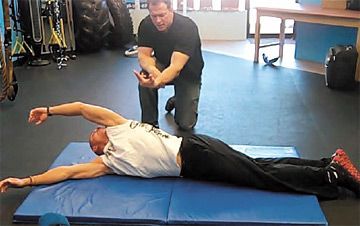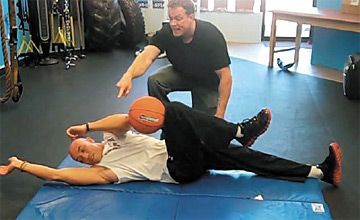On Oct. 21, 2025, a judge in Florida issued a groundbreaking decision in Complete Care v State Farm, 25-CA-1063. It concerns a fact pattern that many chiropractic doctors have faced wherein an insurer, such as State Farm or Allstate, decides to simply stop paying all claims submitted by a healthcare provider.
| Digital ExclusivePrimal Rolling Patterns for Core Sequencing and Development
In my practice I see the worst of the worst; people of all types living with unrelenting chronic pain. One moment I can treat a high-level athlete suffering from an injury keeping them off the field; the next, a stay-at-home Mom who just wants to play with her children without pain. Most clients have been through the usual channels of rehabilitation and intervention with little or no long-lasting improvement. They have no real answers as to why pain resumes when they start moving and begin integrating simple activities of daily living such as sitting, standing, lifting, walking, etc.
What is the missing component? Stability – the ability to control movement under change. Uncovering an underlying fundamental stability dysfunction is a critical foundation of functional movement patterning. Going back to primal basics of fundamental movement and core sequencing reveals just how vulnerable a client is to re-injury. In order to discover why clients are in pain, as opposed to just chasing their symptoms, one must look at core function and neural sequencing.
The primary rule in chronic pain: If you have pain, you have a movement problem! Knowing how to discover that problem begins with assessing inner core function. What is the simplest way to assess sequencing and core control? Primal rolling patterns.
Inner vs. Outer Core

What is the inner core? People mistakenly think that all "core" is created equal. Not so. You actually have an inner core and an outer core. The inner core is like a cylinder made up of the pelvic floor as the base, the diaphragm as the top, the transverse abdominis (TrA) muscle as the anterior border and the lumbar multifidus (LM) muscles as the posterior border.1 The function of the inner core is both physiological and mechanical, as its main role is to provide the muscle activation required to sustain respiration, continence, and segmental spinal stabilization.
Think of the inner core as your "reactive core," meaning it should engage without thought in order to support outer core function. It acts as a fundamental stabilizer. Critical point: The inner core must engage, activate or "fire" prior to the outer core or abnormal compensation patterns develop in movement, resulting in possible injury.

What is the outer core? The outer core is what most professionals think of when talking about core development. The outer core is comprised of large, multiarticular muscles such as the erector spinae, the rectus abdominis and the external obliques. The outer core provides postural stability, produces movement and resists external loads.
Most people train their outer core without giving any attention to the inner core. If there is an altered firing pattern and the outer core is overloaded, then the body reaches a "high threshold strategy" (HTS)2 – a response by the central nervous system to increase activation to the outer core, which leads to 24/7 muscle activation and the propensity for trigger points, muscle fatigue and fascial restriction issues. When nothing seems to alleviate soft-tissue and movement problems, stop chasing the pain and look deeper inside at fundamental core stability.
How Rolling Patterns and Core Function Are Connected
How does assessing and improving rolling patterns enhance core function? Movement dysfunction is typically a problem with timing and stabilization, rather than a deficiency in strength of prime global movers. It stands to reason that we should address muscle timing and activation. Rolling patterns can function as a basic assessment in a client's ability to shift weight, cross midline, and coordinate movements of the extremities and the core.
Abnormalities of the rolling patterns frequently expose proximal to distal and distal to proximal sequencing errors, or proprioceptive inefficiency that may present during general motor tasks. Many adults have lost the ability to capture the power or utilize the innate relationship of the head, neck, and shoulders to positively affect coordinated movements.3
Rolling patterns should be assessed after ensuring proper mobility exists in the thoracic spine. Why? Stability exercises will not inherently correct a mobility problem. Adequate thoracic spine rotation is a prerequisite for rolling. If, during assessment, the different rolling tasks are not symmetrical and equal, then you should consider that foundational mobility or neuromuscular coordination may be compromised.
However, the body may also decrease mobility due to a fundamental loss of stability over time. The nervous system will "lock down" joints in an effort to gain stability lost from dysfunctional soft-tissue balance. It's a last-ditch "emergency brake" protective mechanism by the brain to gain critical stabilization.
Be proactive and assume stability is always a factor in rehabilitation programming. Determining where and when it fits into the program should be based on the individual client.
Rolling Tests / Corrections
The wonderful thing about rolling is that the test is also the corrective. If a client has difficulty rolling, the way to improve it is to have them do more rolling. How easy is that? However, we also need to give them some ways to make it a bit easier to train these rolling movements until they can do a fully functional, quality roll.
You do not want to make it too difficult for them. Make it challenging, but not difficult. Too much struggle or too much rolling at once can overwhelm the neurological system and the client may fall back on bad movement patterns. The brain will follow the path of least resistance and rely on faulty movement patterns to accomplish the intended task. Start with these five rolls on either side:
- Supine to prone, upper-extremity driven
- Prone to supine, upper-extremity driven
- Supine to prone, lower-extremity driven
- Prone to supine, lower-extremity driven
- Hard roll (knee to opposite elbow)
Cuing (if necessary): 1) Look with the eyes and head. 2) Reach arm across body and turn head into shoulder. 3) Elongate the axis: make the axis (left) leg long – "reach"; make the axis (right) arm long – "reach." 4) Stay long through the axis. 5) Verbal sequence: "Reach-lift arm-look into shoulder-roll"
Key component: Turning and using the head is the secret to completing a successful rolling pattern. You cannot power this movement. It must be a neurological corrective. Clients will notice an immediate change in ease of movement when they stress the eyes and neck turning.
What to look for if they have difficulty rolling: The clientmay suffer from decreased mobility in the cervical spine, hip, shoulder or thoracic spine. Try some soft-tissue techniques, such as foam rolling or trigger-point rolling using a tennis ball, and then recheck the patterns for improvement. If you find improvement in rolling in regard to effort of movement and overall increased motion, work on the soft-tissue prior to rolling.
Progressions: Supine upper extremity > Prone upper extremity > Supine lower extremity > Prone lower extremity > Hard roll bilateral. (Hard-roll movements require precision control of prior supine and lateral rolls before attempting.)
Rolling patterns are a great way to teach a patient how to feel disassociation from the upper and lower parts of the body. This is vital in relationship to the performance of everyday tasks. Make rolling assessments part of every client evaluation to increase the success of long-term maintenance. Do not build strength and mobility without locking in stability. For clients who cannot move well, this drill will be their primary rehabilitation program. Patients will move better and use muscles they never knew existed. That's a good thing.
References
- Cook G, Kiesel K, Plisky P. "The Selective Functional Movement Assessment: An Integrated Model to Address Regional Interdependence" (lecture/presentation), 2010.
- Gill L, Cook G, Voight M, Hoogenboom B. Using rolling to develop neuromuscular control and coordination of the core and extremities of athletes. NAJSP, May 2009;4(2):70-82.
- Cech DJ, Martin S. Functional Movement Development Across the Lifespan, 2nd Edition. Philadelphia, PA: WB Saunders; 2002.


